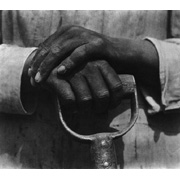| TINA MODOTTI Italian, 1896-1942 |
||
|
Very few photographers are as opposite in their
styles or objectives as Modotti and Erfurth. These differences shine through instructively
in this pair of photographs of hands, made within a year of each other and a continent
apart. Photographers reveal themselves by what they choose to study. Erfurth's
attraction to the intel- lectual and social elite of Weimar Germany is as evident
as Modotti's affinity for the Mexican poor. A revolutionary and a devoted Communist
all of her life, Modotti believed that photography and politics are inseparable.
Her biography is full of drama and change; it is a spy novel leavened by art,
where love and death intermingle in her birthplace in Italy, her adolescence in
San Francisco, her con- version to art in Los Angeles, and her fusion of art and
politics in Mexico City. Modotti learned photography from Edward
Weston in Los Angeles (related to-->> 167, 180,188),
but she had little interest in his art-for-art's-sake approach and quickly focused
on gritty subjects that symbolize labor and the struggle for civil rights. Through
her picture, Modotti declares that the hands of a campesino are as wor- thy a
subject as those of the highest-born aristocrat. |
